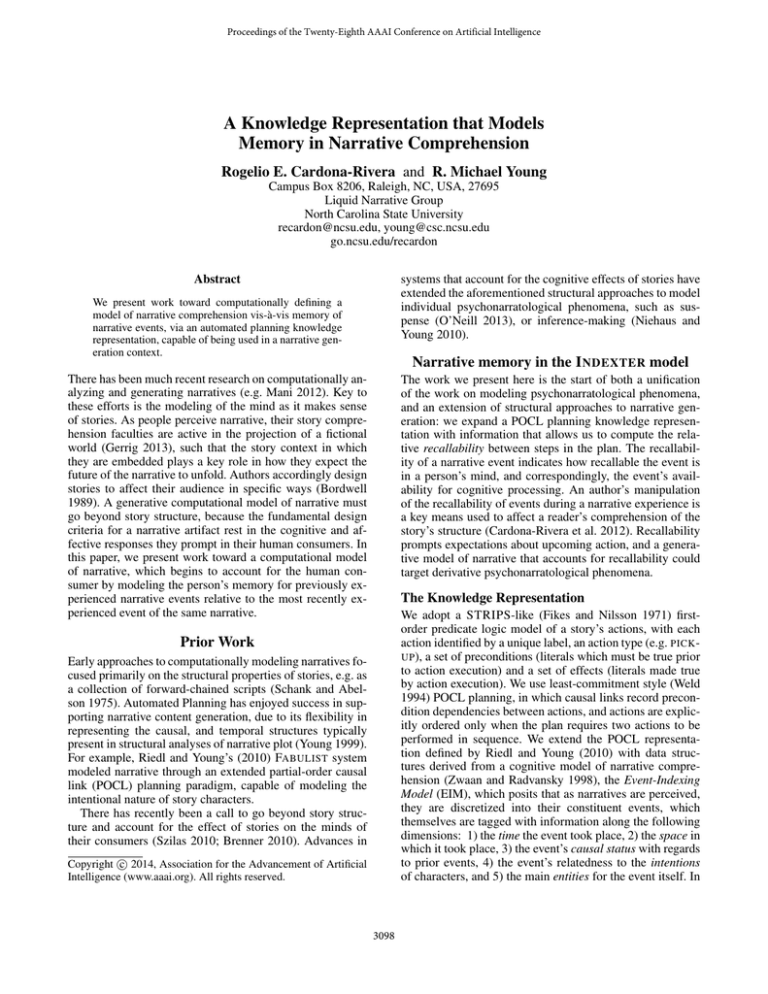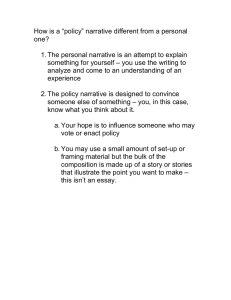
Proceedings of the Twenty-Eighth AAAI Conference on Artificial Intelligence
A Knowledge Representation that Models
Memory in Narrative Comprehension
Rogelio E. Cardona-Rivera and R. Michael Young
Campus Box 8206, Raleigh, NC, USA, 27695
Liquid Narrative Group
North Carolina State University
recardon@ncsu.edu, young@csc.ncsu.edu
go.ncsu.edu/recardon
Abstract
systems that account for the cognitive effects of stories have
extended the aforementioned structural approaches to model
individual psychonarratological phenomena, such as suspense (O’Neill 2013), or inference-making (Niehaus and
Young 2010).
We present work toward computationally defining a
model of narrative comprehension vis-à-vis memory of
narrative events, via an automated planning knowledge
representation, capable of being used in a narrative generation context.
Narrative memory in the I NDEXTER model
The work we present here is the start of both a unification
of the work on modeling psychonarratological phenomena,
and an extension of structural approaches to narrative generation: we expand a POCL planning knowledge representation with information that allows us to compute the relative recallability between steps in the plan. The recallability of a narrative event indicates how recallable the event is
in a person’s mind, and correspondingly, the event’s availability for cognitive processing. An author’s manipulation
of the recallability of events during a narrative experience is
a key means used to affect a reader’s comprehension of the
story’s structure (Cardona-Rivera et al. 2012). Recallability
prompts expectations about upcoming action, and a generative model of narrative that accounts for recallability could
target derivative psychonarratological phenomena.
There has been much recent research on computationally analyzing and generating narratives (e.g. Mani 2012). Key to
these efforts is the modeling of the mind as it makes sense
of stories. As people perceive narrative, their story comprehension faculties are active in the projection of a fictional
world (Gerrig 2013), such that the story context in which
they are embedded plays a key role in how they expect the
future of the narrative to unfold. Authors accordingly design
stories to affect their audience in specific ways (Bordwell
1989). A generative computational model of narrative must
go beyond story structure, because the fundamental design
criteria for a narrative artifact rest in the cognitive and affective responses they prompt in their human consumers. In
this paper, we present work toward a computational model
of narrative, which begins to account for the human consumer by modeling the person’s memory for previously experienced narrative events relative to the most recently experienced event of the same narrative.
The Knowledge Representation
We adopt a STRIPS-like (Fikes and Nilsson 1971) firstorder predicate logic model of a story’s actions, with each
action identified by a unique label, an action type (e.g. PICK UP ), a set of preconditions (literals which must be true prior
to action execution) and a set of effects (literals made true
by action execution). We use least-commitment style (Weld
1994) POCL planning, in which causal links record precondition dependencies between actions, and actions are explicitly ordered only when the plan requires two actions to be
performed in sequence. We extend the POCL representation defined by Riedl and Young (2010) with data structures derived from a cognitive model of narrative comprehension (Zwaan and Radvansky 1998), the Event-Indexing
Model (EIM), which posits that as narratives are perceived,
they are discretized into their constituent events, which
themselves are tagged with information along the following
dimensions: 1) the time the event took place, 2) the space in
which it took place, 3) the event’s causal status with regards
to prior events, 4) the event’s relatedness to the intentions
of characters, and 5) the main entities for the event itself. In
Prior Work
Early approaches to computationally modeling narratives focused primarily on the structural properties of stories, e.g. as
a collection of forward-chained scripts (Schank and Abelson 1975). Automated Planning has enjoyed success in supporting narrative content generation, due to its flexibility in
representing the causal, and temporal structures typically
present in structural analyses of narrative plot (Young 1999).
For example, Riedl and Young’s (2010) FABULIST system
modeled narrative through an extended partial-order causal
link (POCL) planning paradigm, capable of modeling the
intentional nature of story characters.
There has recently been a call to go beyond story structure and account for the effect of stories on the minds of
their consumers (Szilas 2010; Brenner 2010). Advances in
c 2014, Association for the Advancement of Artificial
Copyright Intelligence (www.aaai.org). All rights reserved.
3098
our model, events are isomorphic to plan steps, and thus plan
steps are augmented with situation model index value data.
As defined, Riedl and Young’s representation captures
many of the features needed to represent EIM structures, and
we extended the representation in a model we call I NDEX TER (Cardona-Rivera et al. 2012). Here we introduce data
structures to the I NDEXTER model, and illustrate how these
structures are used to determine what events are expected to
be recallable. Firstly, we model the person’s beliefs about a
story at its onset using a domain model.
events and a specific memory cue. Future work will validate the I NDEXTER model using data collected during the
construction of the EIM cognitive conceptual model, with
the goal of using I NDEXTER to generate narratives designed
to achieve a particular mental (memory) configuration.
Acknowledgments
This work is supported by U.S. DOE CSGF Fellowship No.
DE-FG02-97ER25308. Opinions, findings, and conclusions
expressed here are solely those of the authors.
Definition 1 (Domain Model) A domain model D is a tuple hI, Λ, Gi where I is a set of terms describing a person’s beliefs regarding the initial state of the narrative, Λ
describes a person’s beliefs regarding the set of action operators available in the world, and G describes the set of goals
that the person believes bring about the successful completion of the narrative.
References
Bordwell, D. 1989. Making Meaning: Inference and
Rhetoric in the Interpretation of Cinema. Cambridge: Harvard University Press.
Brenner, M. 2010. Creating Dynamic Story Plots with Continual Multiagent Planning. In Proc. of 24th AAAI.
Cardona-Rivera, R. E.; Cassell, B. A.; Ware, S. G.; and
Young, R. M. 2012. Indexter: A Computational Model of
the Event-Indexing Situation Model for Characterizing Narratives. In Working Notes of the Workshop on Computational
Models of Narrative at the Language Resources and Evaluation Conf., 32–41.
Fikes, R. E., and Nilsson, N. J. 1971. STRIPS: A new
approach to the application of theorem proving to problem
solving. Artificial Intelligence 2(3-4):189–208.
Gerrig, R. J. 2013. A Participatory Perspective on the Experience of Narrative Worlds. Invited talk presented at the
2013 Workshop on Computational Models of Narrative.
Mani, I. 2012. Computational Modeling of Narrative. Synthesis Lectures on Human Lang. Tech. 5(3):1–142.
Niehaus, J., and Young, R. M. 2010. A method for generating narrative discourse to prompt inferences. In Proc. of the
3rd Workshop on Intelligent Narrative Tech., 1–8.
O’Neill, B. 2013. A Computational Model of Suspense
for the Augmentation of Intelligent Story Generation. Ph.D.
Dissertation, Georgia Institute of Technology.
Riedl, M. O., and Young, R. M. 2010. Narrative Planning:
Balancing Plot and Character. JAIR 39(1):164–167.
Schank, R. C., and Abelson, R. P. 1975. Scripts, Plans, and
Knowledge. In Proc. of the 4th IJCAI, 151–157.
Szilas, N. 2010. Requirements for Computational Models
of Interactive Narrative. In Proc. of the AAAI Fall Symp. on
Computational Models of Narrative.
Weld, D. 1994. An Introduction to Least Commitment Planning. AI Magazine 15(4):27.
Young, R. M. 1999. Notes on the use of Plan Structures in
the Creation of Interactive Plot. In Proc. of the AAAI Fall
Symp. on Narrative Intelligence, 164–167.
Zwaan, R. A., and Radvansky, G. A. 1998. Situation models in language comprehension and memory. Psychological
Bulletin 123(2):162–85.
G represents the author’s goals with respect to the form of
the narrative arc. A person will also accumulate new beliefs
about the actions that have occurred since the start of story.
We represent these new beliefs as a chronology.
Definition 2 (Chronology) A chronology is a tuple
hD, S, B, O, L, Ii, where D is a domain model, S is a
set of steps, B is a set of variable binding constraints for
the free variables in the steps in S, O is a set of pairwise
ordering constraints over elements of S, L is a set of causal
links between elements of S, and I is a set of frames of
commitment (Riedl and Young 2010), which represent a
group of intentional actions that agents in a narrative adopt
toward the fulfillment of some goal.
A chronology is consistent just when a) no variable is bound
to more than one object constant, and b) no step required
to come before (or after) another may also come after (or
before) that same step. A chronology is complete when all
preconditions of all steps are satisfied by causal links, no
causal links are threatened by other steps that undo their
causal conditions, and all plan steps belong to some frame of
commitment. It is possible (or even likely) that people will
hold inconsistent models of a narrative world at times, but
we defer the representation of explicitly inconsistent models
for future work.
The I NDEXTER Memory Model
The subsequent equation assumes we can determine situation model index values for all events in question. in question. Succinctly, the recallability of an event e∗i given the
chronology C with memory cue q, is the ratio of the number
of index values shared between e∗i and q to the total number
of shared index values between q and all events ei ∈ C presented to the human consumer.
overlap(e∗i , q)
ei ∈C overlap(ei , q)
(1)
overlap(ex , ey ) = # of index values shared by ex and ey
(2)
recallability(e∗i , q, C) = P
We consider recallability as a dimensionless quantity,
which only makes sense in the context of other narrative
3099



